Have you wanted to raise pigs on your farm but didn’t know how to start? If you are about to buy your first pig, this guide is all you need.
Raising pigs is very easy and simple. Pigs are valued for their meat and their manure.
Your pigs need a secure, dry place to live that provides enough space to move around. Secure your pigs with a strongly built fence and shelter from the elements. Always provide fresh water and pre-mixed feeds to ensure that your pigs have a well-balanced diet.
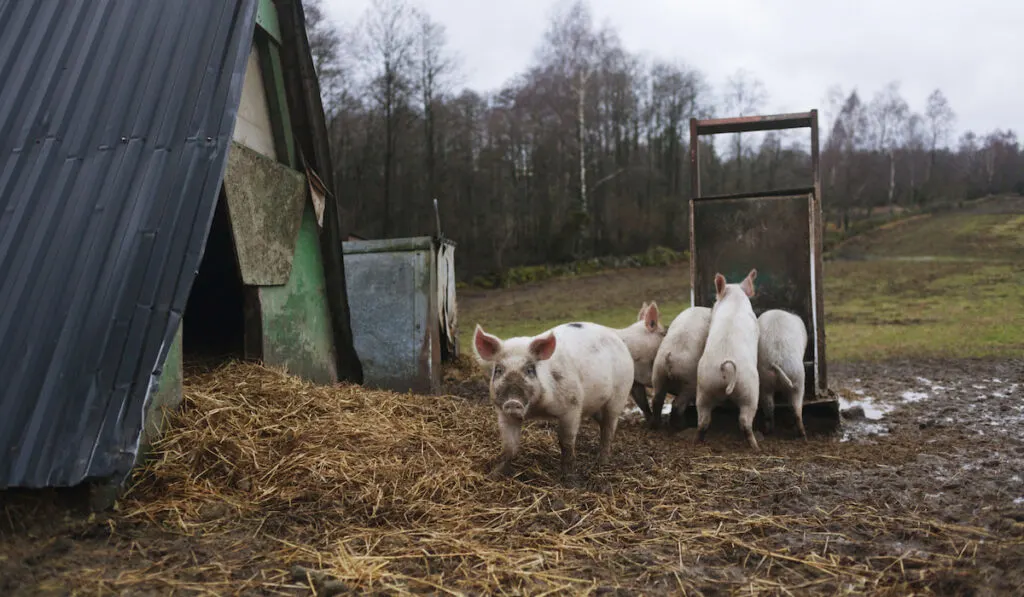
Whether you plan to raise pigs for their meat or to sell at the market, you should know how to build a pigpen and care for your pigs. Here we explain everything you need to know how to raise pigs on your farm or homestead.
Table of Contents
Build a Pig Pen
Your pigs need a safe, secure, dry area to live in. Your pig pen should protect your pigs from rain and snow and high winds. Build a pig pen that provides enough space for your pigs to move around easily. For healthy pigs, you should give every pig 50 square feet of living area.
When you decide to build your pig pen, keep in mind that pigs like to relieve themselves near the water supply. It is better to put the water supply far away from the food and shelter area.
If you want to raise your pigs in a barn, remember that you will need to remove a lot of manure out of the barn. Two feeder pigs can easily be housed in an 8- by 16-foot pen. If pigs are kept indoors, they should be protected from drafts but should also have good ventilation. Install windows that will let fresh air in but keep out the rain. During the heat of summer, fans can help keep pigs cool.
When you build a pigpen, make sure your pigpen is a minimum of three feet high. As your pigs grow, this height is tall enough to keep them in safely. Pigs are strong; make sure the fence is secure and sturdy. Galvanized mesh panels are great for pig pens on the bottom to stop digging. Make sure the fence is tightly drawn. Wood and other fence options will also work if you choose to use them.
Pigs create separate areas for their daily activities. Make sure to give your pigs enough space to move between the spaces they choose to:
- Eat
- Drink
- Eliminate waste (Pigs instinctively eliminate their waste away from where they sleep)
- Sleep
Place the bedding accordingly to keep the dry and wet areas separate so your pigs can rest in a dry and clean space.
Place the waterers and feeders in separate areas. This will encourage your pigs to exercise. Pigs don’t need to run around to release energy like other animals do. But they do need to move around to encourage bone development and muscle tone. If your pig pen is too small, a dominant pig in the group could control the feeder. Encouragement to move will support your pig’s wellbeing.
Outdoor Pig Pen
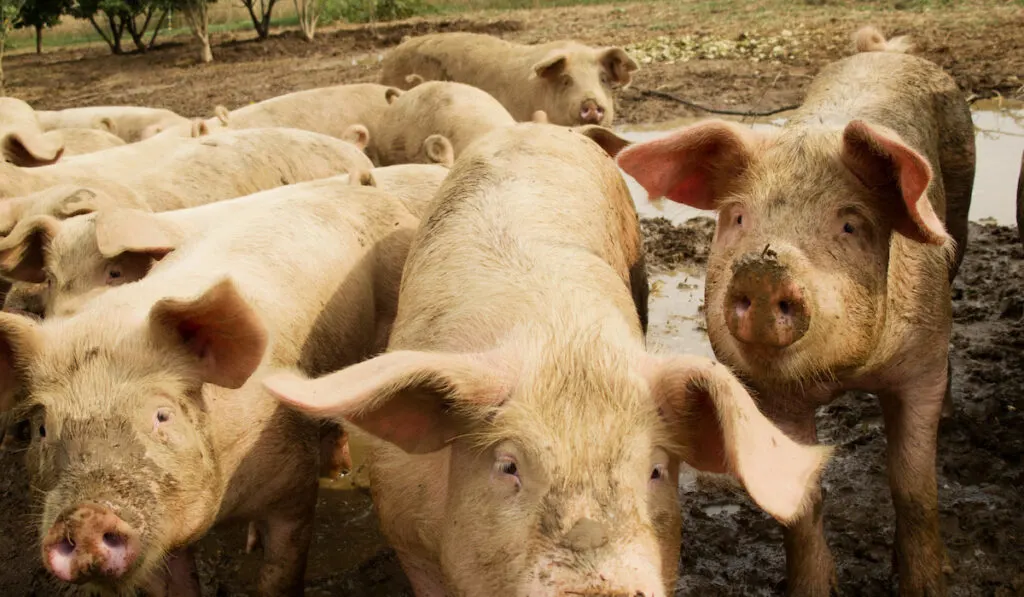
If you decide to raise your pigs outdoors in a pasture, calculate at least 20 square feet per pig. Even though the pigs will live outdoors, they need shelter from the weather.
Provide a three-sided shelter that will give your pigs shade in the summer and keep them dry in rain or snow. Depending on how many pigs you plan to keep will determine the size of the shelter. Pigs usually huddle together when it is cold. When hot, your pigs want room inside the shelter to lie down away from each other in the shade.
Pigs raised outside like to dig in the soil with their snouts. Keep an eye on where they are digging the holes to avoid becoming an escape route later. Installing an electric fence is a good idea for pigs living outdoors.
If you want to raise your pigs at pasture, 25-35 pigs per acre is a good rule of thumb to figure out the space you need. This means that you can easily raise 8-9 pigs on a ¼ acre of land.
Shelter
Pigs can easily get sunburn if they do not have shelter to protect them from sunlight. They need protection from rain, cold, and wind in wintertime. Place hay down inside the shelter that your smaller pigs can warm themselves in cold winter months.
The best shelter to give your pigs is a roofed structure with three sides placed inside the pigpen.
Provide a cover of at least 20 square feet for shade. Leave a small opening under the eaves of the shelter for heat to get out can during the summer months.
A Mud Hole
Give your pigs a mud hole. Yes, it is true; pigs love mud. They struggle to regulate their body temperatures. In very hot temperatures, a mud hole is a place to cool down.
Section off one part of the pigpen to build a mud hole. Build a low-lying trough or fence around it to keep the mud in just one area of the pigpen. Dig up the ground for the mud hole and add water to the area a few times a day. It is a good idea to add sand at the bottom of your mud hole when you dig it first.
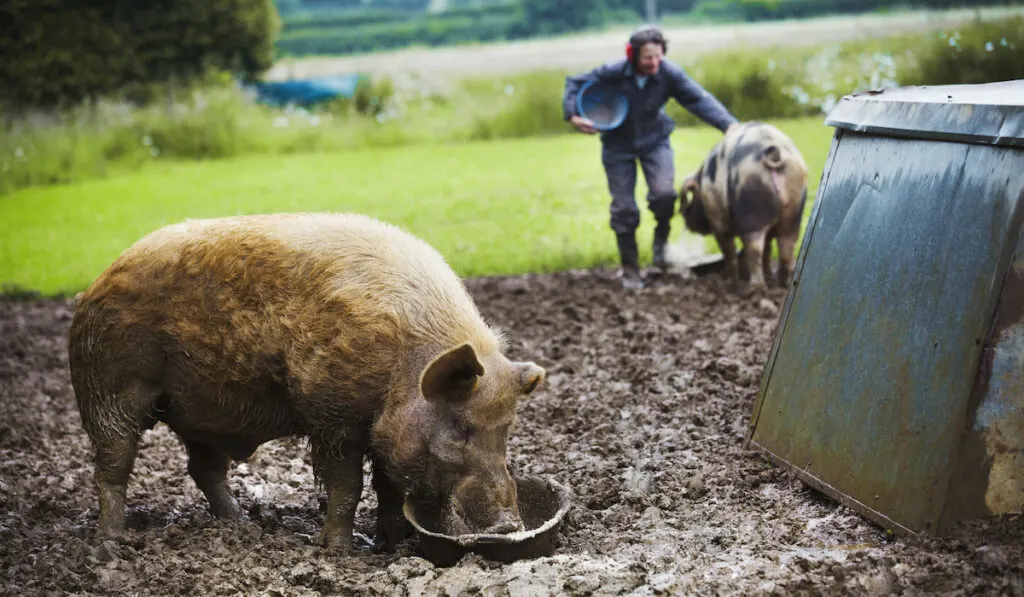
As time goes on, add fresh sand when the hole needs it.
Keep the mud hole clean because sometimes pigs will go to the bathroom in it.
When pigs wallow in the mud, it reduces lice and other biting insects. When pigs are allowed to root the ground, it keeps them happy and occupied. Rooting the ground is something they enjoy doing. Wallowing in mud keeps your pig’s skin healthy.
Pig stress in hot weather can cause a heat-related heart attack. Use a large kiddie pool if you do not have space for a mud hole.
What to Do with All That Manure
A 100-pound pig is capable of producing around 2 pounds of manure each day. Use manure to fertilize your garden plants. Selling the manure to other gardeners or farmers in your area is also an option.
Control Flies Around the Pig Pen
You should control the flies around your pigpen. When you clean up in pen, cover the spots of urine with a layer of garden lime. Garden lime can easily be bought from a garden supply store. This kills fly eggs and reduces smells. Treat the manure pile with lime, too, if you use it for your garden.
Common garden lime is used on football fields, and it is entirely safe for animals and humans. Garden lime is also used to freshen horse stalls.
Raising the Pigs
Buy your pigs. Piglets grow fastest when the weather is warmer from 60 to 70°F. Start your pig raising in spring or late summer when piglets are growing fastest. A piglet with constant access to water and food will grow 250 pounds in about 100 days.
Choose a healthy pig from a reputable farmer if you plan to raise pigs productively. Search around in your local area for piglets. When choosing piglets, do not buy any pigs who are coughing or scratching. Look at the rest of the herd; if any of them look sick or skinny, consider buying your piglets elsewhere.
Try to buy heritage breeds of pigs to help preserve old breeds that are near extinct. Raising pigs that have not been subjected to factory farm growth hormones, excessive antibiotic treatments, or manipulating genetic breeding is a better way to raise pigs on your farm.
Water. Pigs drink a lot of water. Typically, pigs will drink 4 gallons of water every day. Always provide your pigs with clean drinking water.
Make sure you fix your water tub to the ground. If you leave the water tub on the ground, the pigs will probably topple it over and spill the water.
There are many inexpensive water troughs available for purchase that can be connected to a water source. These troughs control the water via a float system which avoids constantly filling a water tub.
Feed. Choose a good pre-mixed pig feed. Ready-mixed feeds provide your pigs with a balanced diet. Do not feed your pigs on the ground. Throwing grain on the ground for them to eat as you would for chickens will expose them to parasites and provoke a worm infestation. A feeding trough with separate openings large enough for each pig to put its head through is the way to go.
A piglet should gain about 1 lb. each day.
Age to Weight ratios:
- Piglets of 8 weeks weighing 40 pounds should eat 2 pounds of 17-18% protein
- Piglets of 12 weeks weighing 75 pounds should eat 2-3 pounds of 15% protein
- Piglets of 16 weeks weighing 125 pounds should eat 4-5 pounds of 14% protein
Human Food Snacks. If you have leftover kitchen scraps, you can give that to your pigs too. Pigs love eating anything and everything and are not called garbage disposal units for nothing. But make sure you keep the pre-mixed feed as the main food source and only give the pigs kitchen food as a snack. Pigs can feed on vegetables, fruits, garden clippings, meat scraps, and eggs.
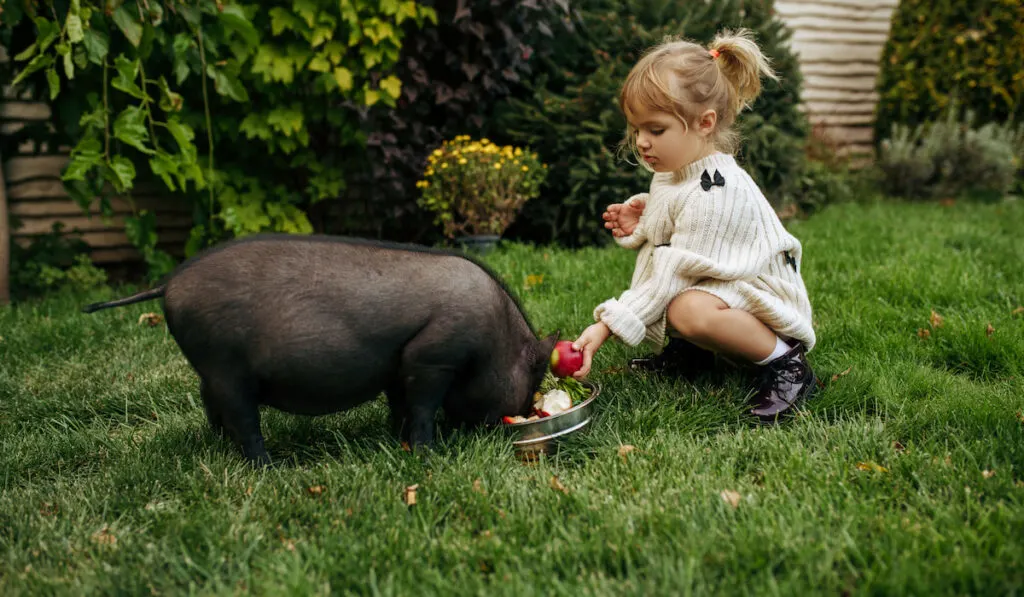
Remember, poisonous foods like rhubarb leaves and certain berries can also be poisonous to your pigs. Do not feed raw meat and raw potatoes; they are poisonous and carry bacteria that can harm your pigs.
Rather boil any human food before feeding it to the pigs. Boiling the food guards against any bacteria that the food might harbor.
Parasite control. Protect your pigs against internal parasites. They tend to get internal parasites because of all the mud rooting that goes on all day. Speak to your veterinarian to prescribe a de-wormer that will eliminate any worms. De-worm your pigs every six weeks.
Selling your pigs. Pigs can be sold for profit. Sell your pigs when they reach 200 to 250 pounds (90 to 114 kg). Pig prices at the market are based on health and weight. Take your pigs to an auction that sells livestock or sell them to other would-be pig farmers.
Take care. Note pigs can be dangerous. When a 100 lb. pig hits you on your legs, it will pack a punch. A pig’s bites can be dangerous too because pigs have sharp teeth. It is a good idea to keep boards for sorting around the pigpen to move pigs into their pens and grab them if necessary.
These sorting boards are rectangular, around 30″ x 48″ with cutouts across the top and sides for your hands to hold onto. They are cheap and easily available at feeds stores, or you could buy them online.
You can even make your own using a piece of wood the size mentioned and attach handles for ease.
Pig Husbandry Tips
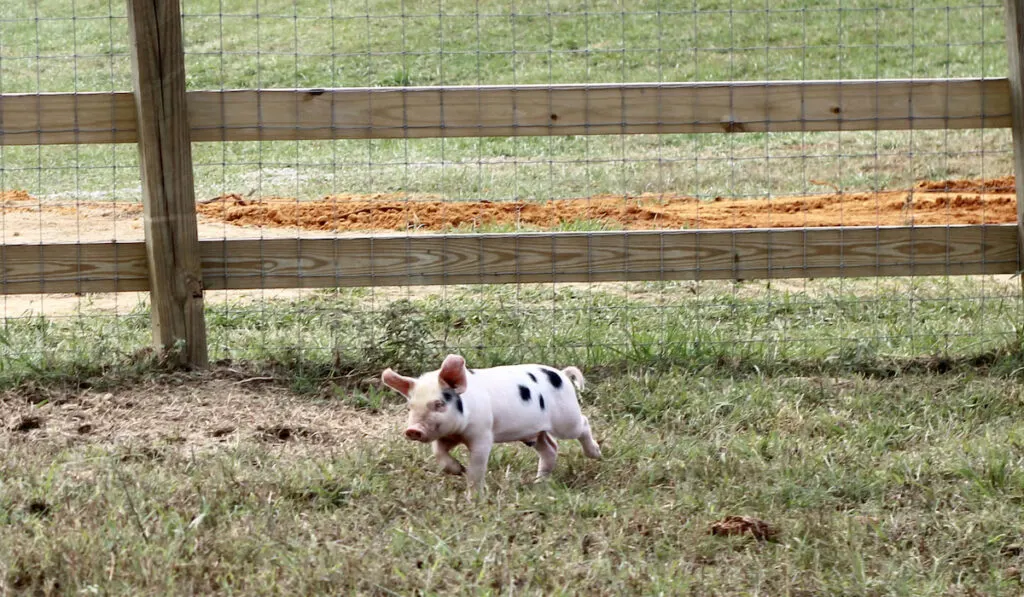
- A healthy sow can produce a litter of ten to twelve piglets and generally weighs about 350 pounds.
- Pigs are ready for the market when they reach the 250-pounds. Raising pigs on a farm to reach 250 pounds can take at least eleven months.
- Even though pigs love mud, they like to be clean and are not dirty animals. Pigs will create one spot to relieve themselves to keep the living and sleeping areas clean.
- Pigs are very intelligent and are surprisingly loving. You could quickly fall in love with a piglet and end up with a 350-to-500-pound pet.
- Start raising pigs by buying a weaner. It is called a weaner because it has been weaned from its mother and is about three months old. The piglet will be easy to work with and will not be too intimidating to a first-time pig farmer who has little experience dealing with pigs.
- When your sow starts going into labor, she will build a nest out of branches, leaves, and other material. The nest is made to create a comfortable place to give birth.
- Be careful; no matter how friendly your sow is, she may not think twice about giving you a bite hard enough to bruise or break the skin to keep you away from her litter.
Conclusion
Raising pigs on a farm is easy if you follow the steps we listed above. If you provide your pigs with fresh water, food, and shelter against the elements, you can successfully raise pigs for profit on your farm or homestead without any problems.
